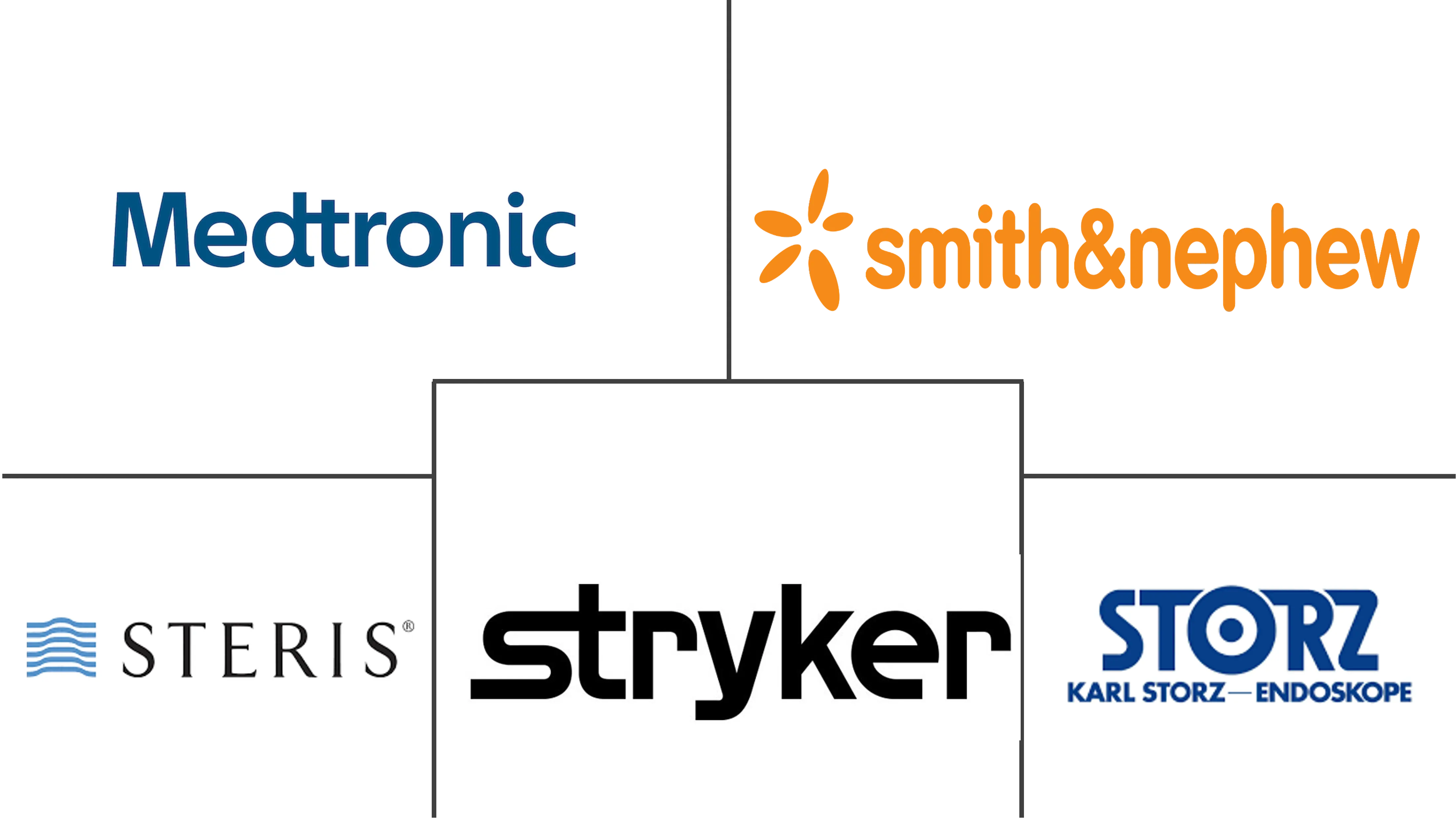Global Insufflation Devices Market Size and Share
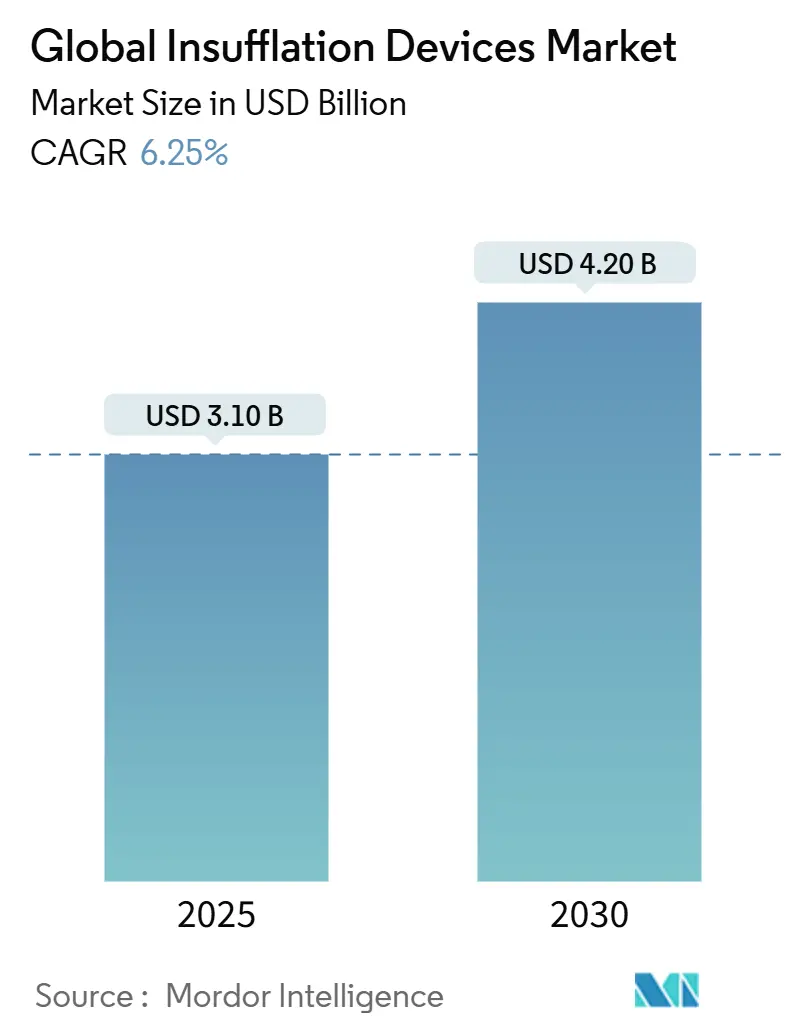
Global Insufflation Devices Market Analysis by Mordor Intelligence
The insufflation devices market size stands at USD 3.10 billion in 2025 and is projected to expand to USD 4.20 billion by 2030, representing a 6.25% CAGR over the forecast period. Rising volumes of minimally invasive procedures, stronger evidence of quicker patient recovery, and payer pressure for total-episode cost reductions are accelerating demand. Rapid integration of insufflation systems with robotic platforms, the rollout of FDA guidance for AI-enabled surgical software, and the shift of complex cases into ambulatory settings are sharpening competitive differentiation. North American providers continue to refresh installed bases for performance-linked contracts, whereas emerging Asian hospitals prioritize first-time purchases of affordable systems. Together, these forces are setting a higher performance bar and widening the technology adoption gap between early and late movers.
Key Report Takeaways
- By product type, insufflation systems held 72.98% of insufflation devices market share in 2024, while disposable tubing and accessories are forecast to register the fastest 7.35% CAGR through 2030.
- By application, laparoscopic surgery accounted for 52.34% revenue in 2024; bariatric surgery is projected to grow at a 7.99% CAGR to 2030.
- By end user, hospitals retained 63.45% of the insufflation devices market share in 2024, whereas ambulatory surgical centers are poised for an 8.69% CAGR, underpinned by a projected 44 million U.S. ASC procedures by 2034.
- By geography, North America dominated with 38.65% share in 2024; Asia-Pacific is on track for the fastest 9.45% CAGR through 2030 as infrastructure investments accelerate.
Global Insufflation Devices Market Trends and Insights
Driver Impact Analysis
| Driver | (~) % Impact on CAGR Forecast | Geographic Relevance | Impact Timeline |
|---|---|---|---|
| Rising prevalence of minimally-invasive surgeries | +1.8% | Global | Long term (≥ 4 years) |
| Technological advances in flow-controlled & heated-humidified insufflators | +1.2% | North America & EU, APAC adoption | Medium term (2-4 years) |
| Growing adoption in bariatric & gynecologic procedures | +0.9% | Global, concentrated in developed markets | Medium term (2-4 years) |
| Expansion of ambulatory surgical centers | +0.7% | North America, emerging in APAC | Short term (≤ 2 years) |
| Integration with next-generation robotic platforms | +0.6% | North America & EU, selective APAC markets | Long term (≥ 4 years) |
| Shift toward single-use insufflation tubing to curb cross-contamination | +0.4% | Global, accelerated in post-pandemic markets | Short term (≤ 2 years) |
| Source: Mordor Intelligence | |||
Rising Prevalence of Minimally-Invasive Surgeries
Minimally invasive techniques now dominate gallbladder removal, colorectal resection and thoracic interventions, pushing the medical insufflation systems market toward reliable, high-flow technology. Laparoscopic approaches already exceed 96% of cholecystectomies and increasingly replace open procedures in bariatric and gynecologic oncology practices. Medicare data show 3.4 million ASC beneficiaries in 2023, underscoring outpatient migration where insufflation enables same-day discharge. Enhanced Recovery After Surgery (ERAS) pathways rely on heated, humidified gas to preserve core temperature and accelerate bowel function. Collectively, these shifts keep demand for insufflators on an upward trajectory within the medical insufflation systems market.
Technological Advances in Flow-Controlled & Heated-Humidified Insufflators
Heated-humidified insufflators maintain core temperature, cut postoperative shivering and prevent hypothermia, driving premium adoption in the medical insufflation systems market. Systems such as AirSeal sustain pneumoperitoneum at low pressure, curtailing subcutaneous emphysema while filtering surgical smoke. Stryker’s PneumoClear couples 50 L/min flow with particulate removal down to 0.051 microns, improving visibility in robotic and standard laparoscopy. Embedded sensors automatically modulate flow in real time, marking a shift from passive to smart insufflation. These innovations widen clinical indications and reinforce the competitive edge of vendors in the medical insufflation systems market.
Growing Adoption in Bariatric & Gynecologic Procedures
Robotic procedures for sleeve gastrectomy and Roux-en-Y require stable low-pressure environments that advanced insufflators reliably deliver. In gynecology, multicenter Indian data confirm 70.9% robotic utilization, citing reduced blood loss and shorter hospitalization. Specialized 50 L/min bariatric modes and contamination alarms meet extended runtime and sterility needs. Surgeons therefore view feature-rich platforms as essential, cementing their uptake within the medical insufflation systems market.
Restraint Impact analysis
| Restraint | (~) % Impact on CAGR Forecast | Geographic Relevance | Impact Timeline |
|---|---|---|---|
| Post-operative CO₂-related complications (e.g., hypercapnia) | -0.8% | Global, higher impact in emerging markets | Medium term (2-4 years) |
| High capital cost of advanced units | -0.6% | Emerging markets, cost-sensitive segments | Long term (≥ 4 years) |
| Shortage of skilled laparoscopic surgeons in emerging markets | -0.5% | APAC, Africa, Latin America | Long term (≥ 4 years) |
| Environmental regulations constraining medical-grade CO₂ supply | -0.3% | EU, North America, expanding globally | Medium term (2-4 years) |
| Source: Mordor Intelligence | |||
Expansion of Ambulatory Surgical Centers
Roughly 6,300 U.S. ASCs performed 5.7% more procedures per beneficiary in 2023, channeling USD 6.8 billion in Medicare spending. ASC cost advantages over hospital outpatient departments attract payers and patients, heightening the call for portable, rapid-setup insufflators. Smoke-evacuation laws now enforced in 26 states mandate integrated filtration, accelerating equipment refresh cycles ascfocus.org. The convergence of legislative pressure and volume growth positions ASCs as a strategic demand hub for the medical insufflation systems market.
Post-operative CO₂-Related Complications
Gas embolism, hypercapnia and cardiopulmonary strain temper aggressive insufflation pressure settings in vulnerable patients. Altered venous return and reduced cardiac output underscore the need for precise flow control, advanced monitoring and surgeon vigilance. Resource-constrained facilities may lack capnography and anesthesia expertise, magnifying intra-operative risk. Regulatory bodies now emphasize compliance with revised CO₂ insufflation safety guidelines. Such clinical concerns restrict rapid equipment penetration in some settings, restraining portions of the medical insufflation systems market.
High Capital Cost of Advanced Units
Next-generation insufflators integrate heating, humidification and smoke filters, pricing many models beyond smaller hospital budgets. Under the EU Medical Device Regulation, certification expenses can exceed EUR 100,000, prolonging time to market and pushing list prices higher. In countries with limited capital budgets, providers often prioritize refurbished devices, slowing replacement cycles. Extended training and maintenance add to ownership costs, challenging adoption in cost-sensitive geographies. Consequently, upfront price remains a measurable brake on the medical insufflation systems market
Segment Analysis
By Product Type: Systems Drive Revenue While Accessories Fuel Growth
Insufflation systems anchor surgical suites, delivering 72.98% revenue in 2024 as hospitals standardize on network-ready consoles that integrate with OR information systems. The sizeable installed base underpins long-term service contracts and periodic software upgrades that lift recurring revenue streams. In contrast, accessories such as single-use tubing, filters, and valves are registering a 7.35% CAGR, propelled by infection-control guidelines that favor disposables. The insufflation devices market size for accessories is projected to rise in lockstep with procedure volumes, creating a lucrative annuity stream for vendors bundling consumables with capital units.
Hospitals in North America and Europe increasingly negotiate value-based packages, exchanging higher console prices for guaranteed consumable supply deals. Meanwhile, manufacturers embed pressure sensors and RFID chips into tubing sets, enabling auto-calibration and stock tracking that streamline supply-chain workflows. These smart disposables support premium pricing, cushioning margin pressure from cost-sensitive buyers in emerging economies and keeping the insufflation devices market on a robust growth trajectory.
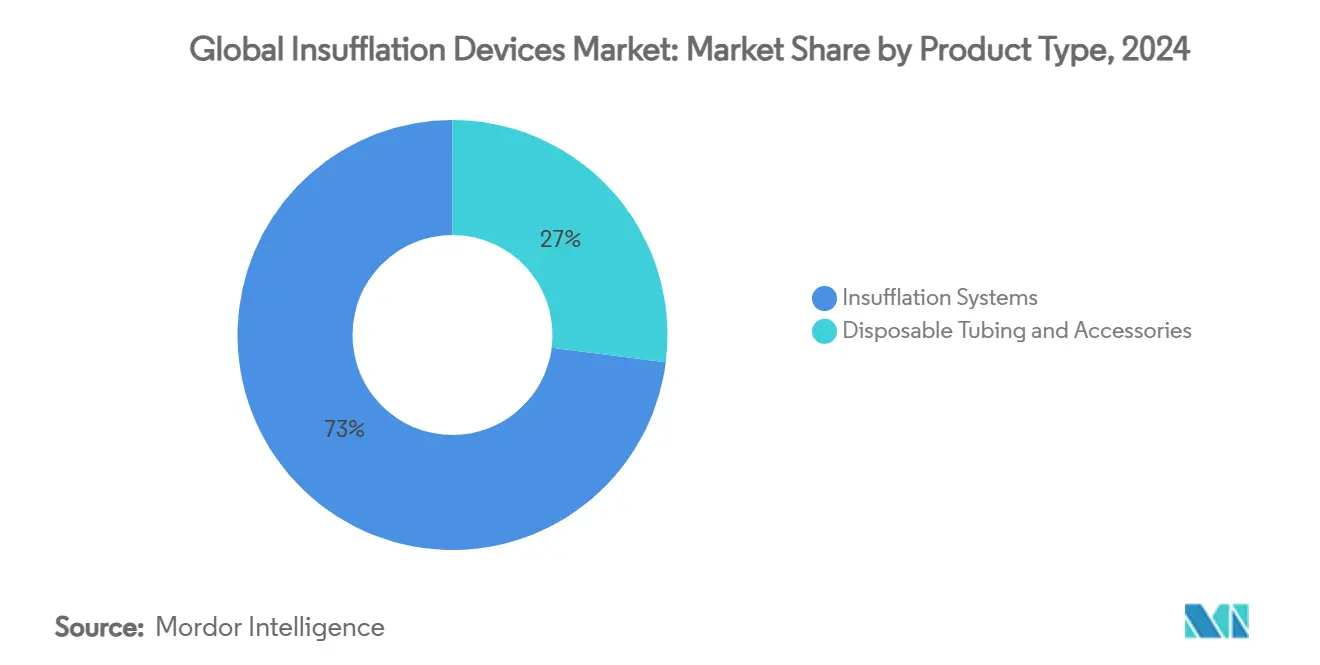
Note: Segment shares of all individual segments available upon report purchase
By Application: Laparoscopic Surgery Dominates While Bariatric Procedures Accelerate
Laparoscopic interventions controlled 52.34% of revenue in 2024, reflecting their ubiquity across general surgery, colorectal, and urology departments. Hospitals leverage standardized lap sets to train residents quickly, reinforcing procedural stickiness. The insufflation devices market size attached to bariatric surgery is expanding fastest, with a 7.99% CAGR through 2030 as obesity rates climb and insurers widen coverage. Robot-assisted platforms already account for 30% of U.S. bariatric volume, demanding insufflators capable of maintaining stable pneumo-spaces during complex maneuvers.
Gynecologic surgeons adopt AI-driven pressure modulation to navigate narrow pelvic planes, while cardiac teams require ultra-low-flow modes to protect hemodynamics. “Other surgeries” such as pediatric thoracoscopy and transanal endoscopic microsurgery are emerging niches that value portable, low-noise pumps. Collectively, these specialized uses diversify revenue sources and ensure the insufflation devices market maintains momentum even as core laparoscopic volumes mature.
By End User: Hospital Infrastructure Enables ASC Growth
Hospitals held 63.45% revenue in 2024, retaining complex oncology, transplant, and trauma workloads that require advanced multi-port insufflation systems linked to anesthetic workstations. Yet the ambulatory surgical center segment is scaling at an 8.69% CAGR, forcing suppliers to rethink product design around compact footprints, plug-and-play disposables, and rapid turnover features. The insufflation devices market share captured by ASCs will continue to expand as reimbursement shifts more colon, hernia, and metabolic cases outpatient.
Specialty clinics focusing on reproductive endocrinology or bariatric revisions are early adopters of cloud-connected insufflators that allow remote performance audits. Leasing models and per-procedure subscriptions lower barriers for smaller facilities, broadening geographic reach. Consequently, both large academic hospitals and nimble ASC chains are shaping product roadmaps, ensuring sustained R&D investment across the insufflation devices industry.
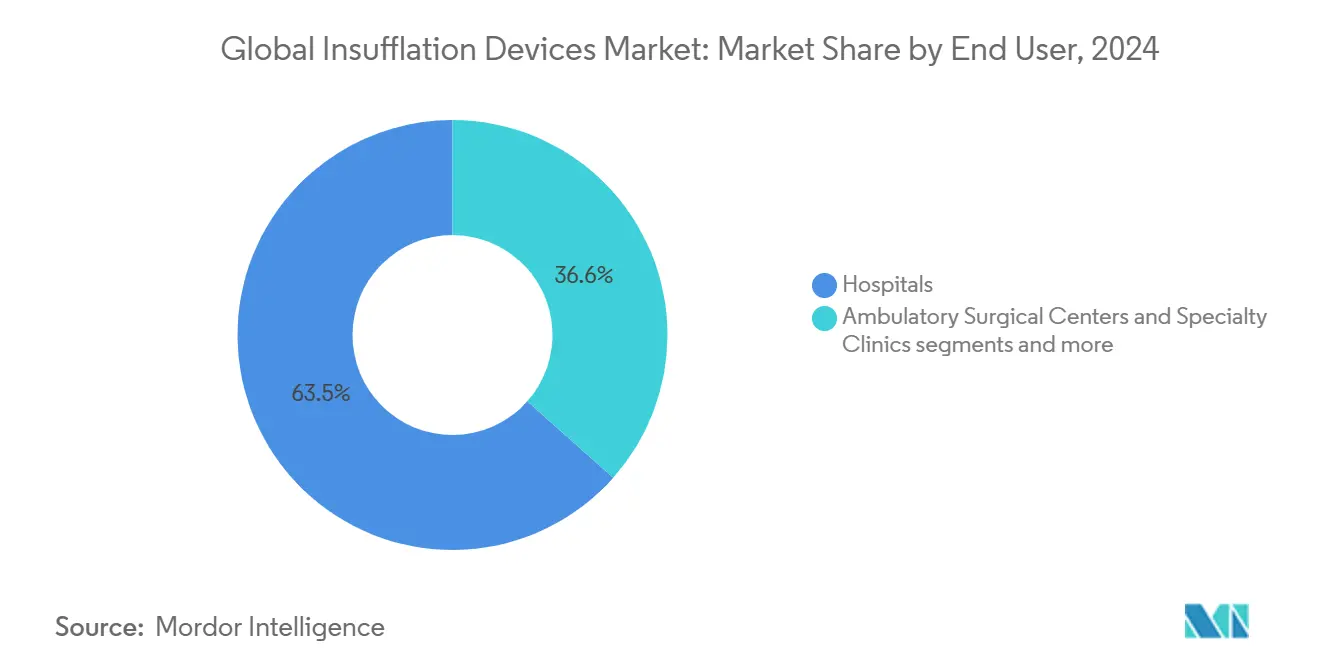
Note: Segment shares of all individual segments available upon report purchase
Geography Analysis
By Geography: North American Leadership Amid Asia-Pacific Acceleration
North America commanded 38.65% of global revenue in 2024, anchored by robust capital budgets, rapid robotic uptake, and a supportive reimbursement framework that rewards shorter stays. U.S. regulators issued 2025 draft guidance for AI-enabled surgical software, encouraging manufacturers to embed analytics and predictive algorithms in next-gen insufflators. Canadian health systems are earmarking funds to refresh aging laparoscopic stacks, while Mexico’s private hospital groups co-invest with suppliers via long-term service agreements to manage cash flow.
Europe maintains stable growth as national health services pursue operating-room efficiency programs. Germany’s 97% laparoscopic appendectomy standard demonstrates entrenched MIS culture, while the European Association for Endoscopic Surgery’s post-COVID guidelines accelerate protocol harmonization. Southern European markets use EU recovery funds to upgrade OR ventilation and smoke evacuation systems, often bundling insufficient pumps in turnkey packages.
Asia-Pacific leads on momentum with a 9.45% CAGR. China’s expedited device approvals and expanded volume-based procurement have opened doors for both multinationals and local innovators. India’s shortage of 13.5 surgical specialists per 100,000 citizens fuels public-private partnerships to establish treatment hubs that require scalable MIS infrastructure. Japan and South Korea, already robotic heavyweights, are piloting AI-enhanced insufflators that integrate with 8K arthroscopes.
South America, the Middle East, and Africa offer selective upside. Brazilian reference centers buy top-tier consoles, whereas broader adoption is hamstrung by training deficits and currency volatility. Gulf Cooperation Council nations incorporate insufflation capacity in greenfield hospital projects, leveraging petrodollar budgets to acquire full robotic suites. Sub-Saharan initiatives lean toward gasless technology to overcome CO₂ logistic hurdles, providing low-cost entry lanes for frugal innovators.

Competitive Landscape
The market is moderately consolidated, with the ten largest vendors controlling roughly two-thirds of global revenue. Established players such as Stryker, Olympus, Karl Storz, Medtronic, and Johnson & Johnson leverage integrated portfolios, channel presence, and service contracts to defend share. Intuitive Surgical’s procedure growth amplifies demand for compatible insufflators, spurring tie-ups between console makers and pump suppliers. Teleflex’s acquisition of BIOTRONIK’s vascular arm underscores a strategy of adjacency expansion that cross-pollinates customer bases.
Differentiation now hinges on AI-driven flow control, smoke evacuation, and environmental conditioning features. New entrants such as Alesi Surgical offer gasless devices targeting low-resource settings, while Chinese producers compete aggressively on price. Regulatory convergence around IEC and ISO standards levels the playing field but raises compliance costs that smaller firms struggle to absorb.
Service-centric models emerge as hospitals seek uptime guarantees and data-driven maintenance. Vendors bundle preventive analytics dashboards and on-site support, locking customers into multi-year agreements. Sustainability programs—ranging from recyclable tubing to energy-efficient pumps—offer further levers for customer retention, as providers align capital spending with corporate ESG targets.
Global Insufflation Devices Industry Leaders
-
Medtronic
-
STERIS
-
Stryker
-
Smith & Nephew
-
Karl Storz
- *Disclaimer: Major Players sorted in no particular order
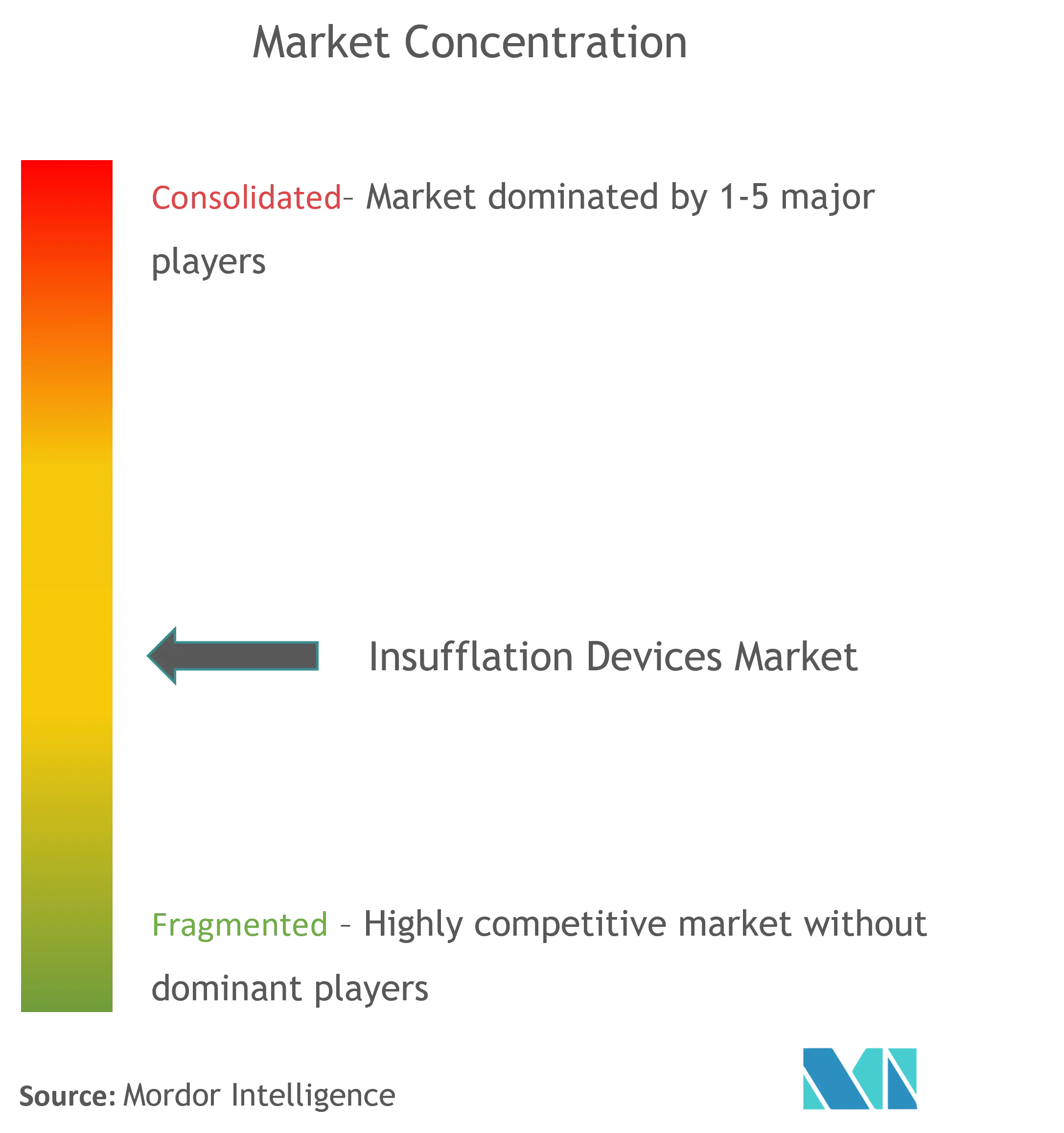
Recent Industry Developments
- December 2024: Karl Storz and Artisight introduced Pathway.AI, an ambient computer-vision platform that automates OR task sequencing and alerts cleaning staff in real time
- August 2024: Karl Storz finalized its acquisition of Asensus Surgical to bolster robotic and digital surgery assets, notably the LUNA platform
Global Insufflation Devices Market Report Scope
As per the scope of this report, insufflation is the act of blowing gas, powder, or vapor into a body cavity. Gases are often insufflated into a body cavity to inflate the cavity for more workroom during various surgery. The Insufflation Devices Market is Segmented by Application (Laparoscopic, Endoscopic, and Others), End-users (Hospitals, Clinics, Ambulatory Surgical Centers), and Geography (North America, Europe, Asia-Pacific, Middle-East and Africa, and South America). The market report also covers the estimated market sizes and trends for 17 countries across major global regions. The report offers the value (in USD million) for the above segments.
| Insufflation Systems |
| Disposable Tubing & Accessories |
| Laparoscopic Surgery |
| Bariatric Surgery |
| Gynecological Surgery |
| Cardiac Surgery |
| Other Surgeries |
| Hospitals |
| Ambulatory Surgical Centers |
| Specialty Clinics & Others |
| North America | United States |
| Canada | |
| Mexico | |
| Europe | Germany |
| United Kingdom | |
| France | |
| Italy | |
| Spain | |
| Rest of Europe | |
| Asia-Pacific | China |
| India | |
| Japan | |
| South Korea | |
| Australia | |
| Rest of Asia-Pacific | |
| South America | Brazil |
| Argentina | |
| Rest of South America | |
| Middle East and Africa | GCC |
| South Africa | |
| Rest of Middle East and Africa |
| By Product Type | Insufflation Systems | |
| Disposable Tubing & Accessories | ||
| By Application | Laparoscopic Surgery | |
| Bariatric Surgery | ||
| Gynecological Surgery | ||
| Cardiac Surgery | ||
| Other Surgeries | ||
| By End User | Hospitals | |
| Ambulatory Surgical Centers | ||
| Specialty Clinics & Others | ||
| By Geography | North America | United States |
| Canada | ||
| Mexico | ||
| Europe | Germany | |
| United Kingdom | ||
| France | ||
| Italy | ||
| Spain | ||
| Rest of Europe | ||
| Asia-Pacific | China | |
| India | ||
| Japan | ||
| South Korea | ||
| Australia | ||
| Rest of Asia-Pacific | ||
| South America | Brazil | |
| Argentina | ||
| Rest of South America | ||
| Middle East and Africa | GCC | |
| South Africa | ||
| Rest of Middle East and Africa | ||
Key Questions Answered in the Report
What is the current size of the medical insufflation systems market?
The market generated USD 3.10 billion in 2025 and is forecast to reach USD 4.20 billion by 2030.
Which region leads the medical insufflation systems market?
North America holds 38.65% of global revenue owing to dense ASC infrastructure and strict smoke-evacuation mandates.
Why are ambulatory surgical centers important for market growth?
ASCs deliver procedures at lower cost, are projected to handle 44 million U.S. cases by 2034, and require compact, rapid-turnover insufflators to maintain high throughput.
4. What geographic region offers the highest growth potential?
Asia-Pacific shows the fastest 9.45% CAGR, driven by infrastructure investments, regulatory reforms, and rising surgical volumes in China and India.
Page last updated on:
